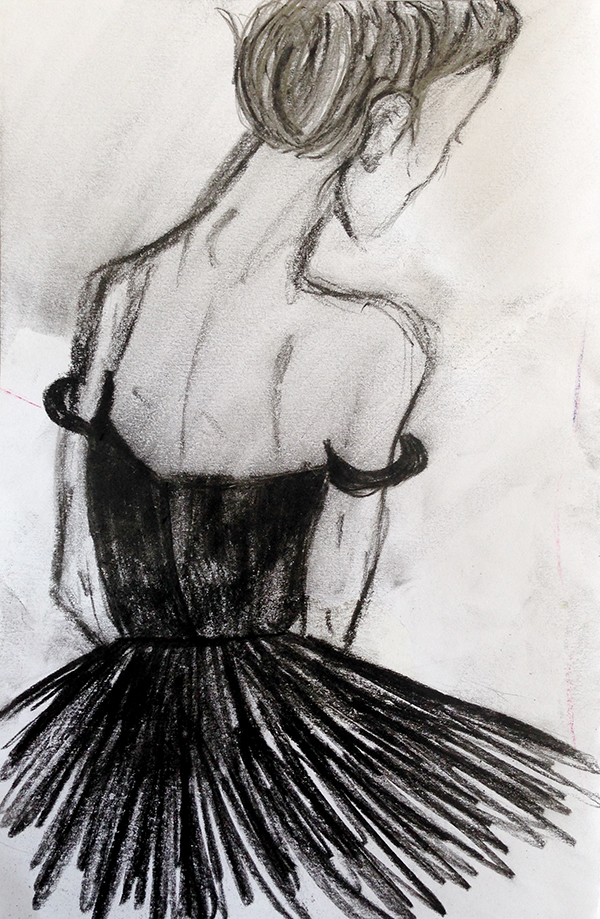On Being a Good Ballet Feminist
BY EMMALY WIEDERHOLT; ILLUSTRATION BY RACHEL PRENDERGAST
I consider myself to be a good feminist. By that I mean I live my life in a way that doesn’t depend on any one man for my wellbeing, I actively support and promote women who are making achievements in their individual fields, I read feminist literature, and I try to de-internalize oppressive narratives I may have swallowed as a young woman growing up in a hierarchical culture where the top is dominated by men.
So don’t ask why it’s taken me so long to get around to being a good feminist when it comes to ballet.
For those of us who love ballet and are intimately familiar with the form, we take it for granted that women are a dime a dozen. We understand the competitive nature of the field, and thus may wince a bit when men are more readily promoted or given scholarships, but we understand it’s supply-demand.
Two events happened recently that made me question my internalized assumptions regarding the place of women in ballet’s hierarchy.
First, Stars of American Ballet recently came to Santa Fe. Directed by Daniel Ulbricht, it’s comprised of a handful of dancers from New York City Ballet who tour to cities across the country. I read through the list of choreographers presented on the program – George Balanchine (classic), Justin Peck (the new doll of NYCB), good ol’ Marius Petipa, Johan Kobburg (a European choreographer I wasn’t familiar with) – when it occurred to me: why are all the choreographers men? I could understand presenting only male choreography if it was a “greatest ballet hits of yore” program, but it included contemporary choreographers too, and nary a one was a woman. I looked on the Stars of American Ballet website, and read that their mission is to travel to cities that rarely offer ballet performances and offer top-notch choreography performed by premier dancers. Aside from the fact my city actually does have a decent ballet company, it struck me that it was a decidedly male view of top-notch choreography.
Some of you might be rolling your eyes at this point, thinking, “Duh!” The emphasis on men choreographing and directing ballet is no news to anyone who has ever opened the program of any ballet company anywhere. There certainly are more women today getting appointed top posts in ballet companies and stepping up to the choreographic plate, but men are predominantly making these appointments and providing these opportunities, in essence still using a male lens to decide who among women merits placement on the top of the ballet hierarchy.
If I sound like I’m ranting, forgive me. I absolutely am.
Then there’s the second event that made me rethink things. A good friend of mine is serving on the board of a well-known dance company in Los Angeles. He asked me to give him a bit of a classical dance history lesson, and I happily obliged. As I rolled from Petipa and the Russian glory days on to Nijinsky and the Ballet Russes, across the pond to Balanchine, Robbins, Joffrey, Ailey, Taylor, etc., then back across the pond to Cranko, Kylian, Forsythe and other European hotshots, I noticed a disturbing trend in my history lesson. Sure, there was Vaganova codifying ballet technique back in the day, Duncan and Graham breaking away from ballet, and a whole host of modern and post-modern female heavyweights, but when it came to ballet choreographers, the only woman who really got a shout out in my historical narrative was Nijinska, and she took backseat to her crazy brother.
These anecdotes gave me pause and caused me to look at my own ballet history. As a young girl, when I decided I wanted to be a ballet dancer, I threw myself into classes and rehearsals with a bottomless frenzy. I devoured biography after biography of famous dancers, swore my allegiance to all things Balanchine, and practically slept in my pointe shoes. But why did I never say to myself, “I want to be a dancer as well as a choreographer and director!” When I envisioned my future life, it stopped at getting into a company. Why did my imagination halt at extreme extensions and wispy limbs, which I understand now is part of a male aesthetic?
To answer all this buzzing in my brain, I recently contacted several women choreographers who are specifically working in ballet. Did they experience a similar limit to their imagination when they were young? When did they take the leap and feel empowered to choreograph? What are the boundaries they’ve faced in the pursuit of choreography? Most importantly, how can we address these issues and turn more young ballerinas into advocates for themselves? The very thoughtful responses I received will be published on Stance on Dance over the coming weeks.
To all aspiring ballerinas out there who probably won’t read this because they are too busy practicing their splits under a poster of Misty Copeland (who I hope goes on to choreograph one day herself), may they grow up with the understanding that their creative contributions and subsequent place in ballet history doesn’t have to stop with great technique.


2 Responses to “On Being a Good Ballet Feminist”
Thanks Janet! I didn’t know about Karen! I hope more people come forward with positive example during this series! Thanks for reading!
The male dominance of an occupation heavily populated with women is not unique to dance…but things do change — Karen Kain (star soloist of the National Ballet of Canada all through the 1970s- 1990s) is the Artistic Director of the National now and has been for some time and is doing a remarkable job!
Comments are closed.